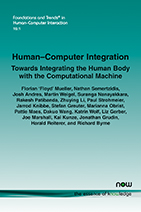Human–Computer Integration: Towards Integrating the Human Body with the Computational Machine
By Florian ‘Floyd’ Mueller, Monash University, Australia, floyd@exertiongameslab.org | Nathan Semertzidis, Monash University, Australia, nathan@exertiongameslab.org | Josh Andres, The Australian National University, Australia, josh.andres@anu.edu.au | Martin Weigel, Technische Hochschule Mittelhessen, Germany, martin.weigel@mni.thm.de | Suranga Nanayakkara, National University of Singapore, Singapore, suranga@sutd.edu.sg | Rakesh Patibanda, Monash University, Australia, rakesh@exertiongameslab.org | Zhuying Li, Southeast University, China, zhuyingli@seu.edu.cn | Paul Strohmeier, Max Plank Institute fuer Informatik, Germany, paul.strohmeier@gmail.com | Jarrod Knibbe, University of Melbourne, Australia, jarrod.knibbe@unimelb.edu.au | Stefan Greuter, Deakin University, Australia, stefan.greuter@deakin.edu.au | Marianna Obrist, University College London, UK, m.obrist@ucl.ac.uk | Pattie Maes, MIT Media Lab, USA, pattie@media.mit.edu | Dakuo Wang, IBM/Northeastern University, USA, dakuo.wang@ibm.com | Katrin Wolf, Berlin University of Applied Sciences and Technology, Germany, kwolf@bht-berlin.de | Liz Gerber, Northwestern University, USA, egerber@northwestern.edu | Joe Marshall, University of Nottingham, UK, joe.marshall@nottingham.ac.uk | Kai Kunze, Keio University, Japan, kai@kmd.keio.ac.jp | Jonathan Grudin, Microsoft Research, USA, jgrudin@microsoft.com | Harald Reiterer, University of Konstanz, Germany, harald.reiterer@uni-konstanz.de | Richard Byrne, Monash University, Australia, rich@exertiongameslab.org
Abstract
Human-Computer Integration (HInt) is an emerging new paradigm in the human-computer interaction (HCI) field. Its goal is to integrate the human body and the computational machine. This monograph presents two key dimensions of Human-Computer Integration (bodily agency and bodily ownership) and proposes a set of challenges that we believe need to be resolved in order to bring the paradigm forward. Ultimately, our work aims to facilitate a more structured investigation into human body and computational machine integration.
Human–Computer Integration: Towards Integrating the Human Body with the Computational Machine
Human-Computer Integration (HInt) is an emerging paradigm in the human-computer interaction (HCI) field. Its goal is to integrate the human body and the computational machine. Because HInt is not an isolated area of research, the authors draw upon discussions from related perspectives, including cybernetics, augmentation, cyborgs, and wearables. While these prior works provide a basis for HInt, and some of their associated challenges also apply to HInt, the authors focus on articulating the HInt challenges that are of particular relevance to HCI.
The monograph makes three contributions: First, the authors apply two key dimensions from psychology – bodily agency and bodily ownership – to enhance our understanding of HInt systems. Second, they use these two dimensions to provide new perspectives on user integration experiences and to develop an integration systems design space. Third, they use the design space and its two dimensions to articulate HInt’s key challenges and group these challenges into four areas: design, society, identity, and technology. Ultimately, the work aims to facilitate a more structured investigation into human body and computational machine integration.
